
A hound is a type of hunting dog used by hunters to track or chase prey.

Scent hounds are a type of hound that primarily hunts by scent rather than sight. These breeds are hunting dogs and are generally regarded as having some of the most sensitive noses among dogs. Scent hounds specialize in following scent or smells. Most of them tend to have long, drooping ears and large nasal cavities to enhance smell sensitivity. They need to have relatively high endurance to be able to keep track of scent over long distances and rough terrain. It is believed that they were first bred by the Celts by crossbreeding mastiff-type dogs with sighthounds. The first established scent hounds were St. Hubert Hounds bred by monks in Belgium during the Middle Ages.

The Black and Tan Coonhound is a breed of hunting dog. Developed in the United States from crosses between the Bloodhound and the Black and Tan Virginia Foxhound, this scent hound runs its game entirely by scent and is used primarily for raccoon hunting.

A coonhound, colloquially a coon dog, is a type of scenthound, a member of the hound group. They are an American type of hunting dog developed for the hunting of raccoons and also for feral pigs, bobcats, cougars, and bears. There are six distinct breeds of coonhound.

The Bluetick Coonhound is a breed of coonhound originating in the United States. The Bluetick Coonhound is known for its friendly personality, cold nose, and deep bawl mouth. It is most commonly used as a raccoon hunting dog, but is also kept as a pet.

The United Kennel Club (UKC) is a kennel club founded in 1898 in the United States. In contrast with the American Kennel Club, which is non-profit and which only clubs can join, the United Kennel Club is a profit-making corporation, open to individuals.

Where the Red Fern Grows is a 1961 children's novel by Wilson Rawls about a boy who buys and trains two Redbone Coonhounds for hunting. It's a work of autobiographical fiction based on Rawls' childhood in the Ozarks.

The American Foxhound is a breed of dog, closely related to the English Foxhound. They are scent hounds, bred to hunt foxes by scent. United States Founding Father George Washington was key to the breed's early development.

The Artois Hound or Chien D'Artois is a medium-sized breed of dog. A scent hound, the Artois was breed in northern France as a pack hunter. It is a rare breed today, but was popular in France before the 20th century. The breed was heavily crossbred and had to be reconstructed in the 1970s to more closely resemble the historical breed.
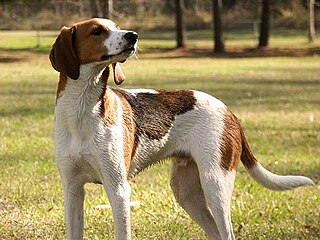
The Treeing Walker Coonhound is a breed of hound descended from the English and American Foxhounds. The breed originated in the United States when a stolen dog known as "Tennessee Lead" was crossed into the Walker Hound in the 19th century. The Treeing Walker Coonhound was recognized officially as a breed by the United Kennel Club in 1945 and by the American Kennel Club in 2012.
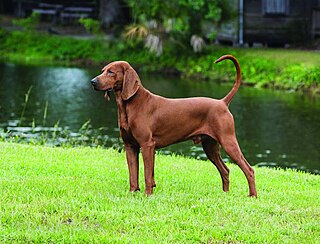
The Redbone Coonhound is an American breed of hunting dog. As a coonhound, the Redbone is primarily a hunter of small game that hide in trees, such as raccoons, opossums, and squirrels, but is also capable of handling big game like bears and cougars. Its hunting strategy is to tree wild game where hunters can then shoot the target, rather than directly hunting and subduing the prey.

The Plott Hound is a large scent hound, originally bred for hunting bears. In 1989, the North Carolina General Assembly designated the Plott Hound as the official State Dog. The Plott Hound was first registered with the United Kennel Club in 1946. Plott Hounds were recognized by the American Kennel Club in 2006 and were exhibited at the Westminster Show in 2008.

A feist is a small hunting dog, descended from the terriers brought over to the United States by British miners and other immigrants. These terriers probably included crosses between the Smooth Fox Terrier, the Manchester Terrier, and the now-extinct English White Terrier. These dogs were used as ratters, and gambling on their prowess in killing rats was a favorite hobby of their owners. Some of these dogs have been crossed with Greyhounds, Whippets or Italian Greyhounds, and Beagles or other hounds —extending the family to include a larger variety of purpose than the original ratter, or Rat Terrier.
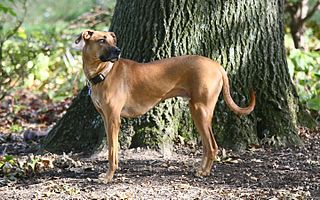
The Black Mouth Cur, also known as the Southern Cur, Southern Black Mouth Cur and the Yellow Black Mouth Cur, is a medium to large sized breed of cur-type dog from the United States. Originating in the south of the country, the breed is a popular hunting companion used to hunt a large variety of game.
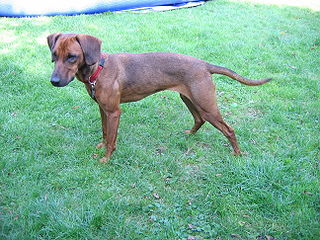
The Tyrolean Hound is a breed of dog that originated in Tyrol also called the Tiroler Bracke or Tyroler Bracke. They are scent hounds that descended from the Celtic hounds in the late 1800s, mainly for their hunting skills. They are hardworking, passionate, and independent dogs not known for their size, but rather their intelligence. For that reason, hunters can regularly use these dogs to catch their prey, wounded or otherwise. Their ability to stretch over long distances, on rough hot or cold terrain for their prey is also another perk of keeping this dog by your side. Hunters do have to worry about injuries to their dog, however, along with the common injuries that these dogs obtain throughout their life, like hip dysplasia or ear infections. Barring any injuries, these dogs tend to live an energetic life for about 12-14 years, and tend to be an overall healthy and robust dog.

The Drever is a breed of dog, a short-legged scenthound from Sweden used for hunting deer and other game. The Drever is descended from the Westphalian Dachsbracke, a type of German hound called Bracke. The breed name Drever was chosen through a contest in 1947.
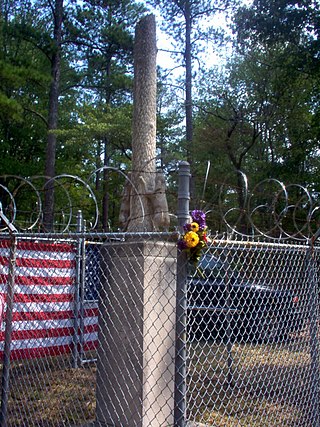
The Key Underwood Coon Dog Memorial Graveyard is a specialized and restricted pet cemetery and memorial in rural Colbert County, Alabama, US. It is reserved specifically for the burials of coon dogs. The cemetery was established by Key Underwood on September 4, 1937. Underwood buried his own dog there, choosing the spot, previously a popular hunting camp where "Troop" did 15 years of service. As of August 2014, more than 300 dogs were buried in the graveyard.
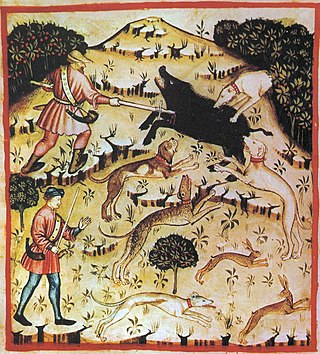
Boar hunting is the practice of hunting wild boar, feral pigs, warthogs, and peccaries. Boar hunting was historically a dangerous exercise due to the tusked animal's ambush tactics as well as its thick hide and dense bones rendering them difficult to kill with premodern weapons.
The Treeing Cur is a breed of dog that originated in the mid-west of the United States. It was first recognized by United Kennel Club on November 1, 1998, due to the efforts of Alex and Ray Kovac. "Most Cur breeders were not well off and so they required a dog that could serve multiple purposes: hunter, guardian, and stock dog. The result was the Treeing Cur, which is the most varied in size and colors of the Cur breeds", according to United Kennel Club. They are primarily used to tree squirrels, raccoons, opossum, wild boar, bears, mountain lion, bobcat as well as to hunt big game.
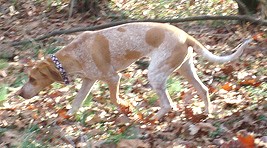
The American English Coonhound, also referred to as the English Coonhound or the Redtick Coonhound, is a breed of coonhound that originated in and is typically bred in the Southern United States. It is descended from hunting hounds, especially foxhounds, brought to America by settlers during the 17th and 18th centuries. The breed's first recognition came from the United Kennel Club in 1905 as the English Fox and Coonhound. Further recognition has been granted in recent years by the American Kennel Club, first in the Foundation Stock Service and in 2011 as a fully recognized member of the hound group.























